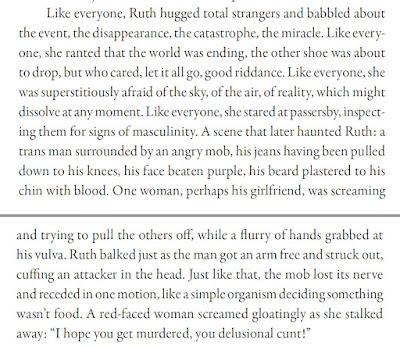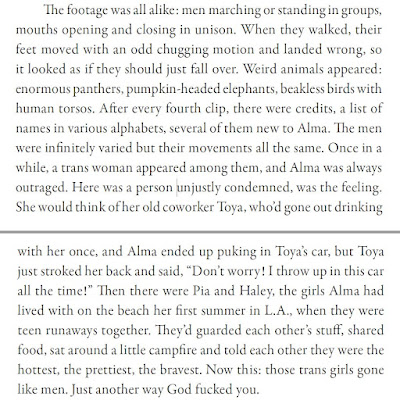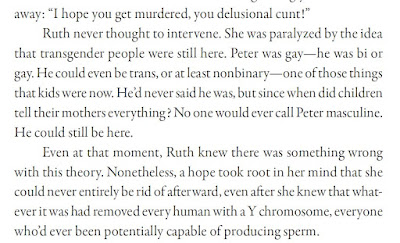QUEER REPRESENTATION (PART 1)
Dedicated fans will find ways to handwave the implications of the premise: the demons are acting in bad faith, or they are alien and do not understand what is evil and what is not, or it was all a dream. With that in mind, what about the other queer representation in this book? After all, Sandra promised that "trans people totally exist and matter in this book", that "there's an important genderqueer character", and that the book is "against gender binaries".
-Trans Men-
Let us start with trans men because it is the topic upon which I feel most qualified to comment. There are three extremely brief references to trans men in this novel.
[TW: Violent Transphobia] One: The first reference occurs hours after the disappearances, during which a trans man is violently assaulted by a crowd of furious women. They strip him naked to "verify" whether a man has been left behind, and then scream death threats at him when they find a vulva instead of a penis.
The POV character for this scene (Ruth, who is not our main POV character, Jane) does nothing to help him and the only impact it has on her is to make her wonder if her queer son might somehow have been left behind too, if he was "trans, or at least nonbinary—one of those things that kids were now. [...] No one would ever call Peter masculine. He could still be here." So we have a violently transphobic scene that adds nothing to the story and its only result is for Ruth to reflect that if OTHER non-masculine people like the trans man were left behind, perhaps her own non-masculine son might have been as well. Score so far: trans men aren't masculine. Thanks.
Some of you have already noticed that a violent crowd is evil, which is one of the many reasons I feel this was a scene added much later in order to "include" trans people. There are no other girl gangs, warlike nations, or references to woman-led violence that I can recall in the novel: just this one scene. I suspect the author would justify this violence in her "utopia" as being a panicky reaction in the immediate wake of the disappearances, and not a "norm" by which her women should be judged; after all, we will later see a trans man in public and he seems not to be in danger. But there is a more grim explanation for this scene: that the trans man is in the wrong for pretending to be something he isn't, and the women are justified in stripping away the falsehood to get to the truth. And you may note that the trans man is able to deflect the mob with a single lash out, after which they melt away--the trans man isn't masculine enough to be taken in the disappearance but still dangerously masculine, causing the cis women to scatter. In real life, trans men are not so easily able to disperse dangerous mobs.
Two: The second reference to a trans man is when the main POV character (Jane) sees a man waiting in a club queue with his girlfriend. Jane assumes the man must be trans because the girlfriend looks bored waiting in line, "not amazed to be standing with the last cis man on planet Earth." Someone who saw trans men as actual people and not trinkets to shove sloppily into a final draft to prove you remembered them MIGHT have reflected that the girlfriend still has plenty reason to be clingy and awed: she is one of very few people on earth in an m/f relationship who didn't lose their romantic partner in the disappearances. She also has to be on alert to protect her boyfriend from the women left behind and their demonstrated violence. But no. Score for this one: trans men aren't as good or interesting as cis men. Cool.
Three: The third and final reference to trans men is so bizarre that I don't even know how to summarize it. We are told that in "a girl world", "trans men could be masculine without making sex into a two-tier system, as cis men always had." I don't even know how to parse this except that it seems to think that all trans men have sex with cis women and no one else. I am left with the impression that the author doesn't seem to know that gay trans men are very common and lots of trans men have male lovers. I also cannot help but notice that this paragraph flows so much better without the "trans men" sentence, which seems to suggest it was a later edit that never quite meshed in place. Scene Score: ???
Trans men are never otherwise mentioned in the novel. Every group scene is described as "women" and "girls". We never otherwise see men in casual passing, whether trans men or intersex men who lack a Y chromosome. The world is narratively described as a "world without men". Final score: trans men are invisibled and misgendered (by being lumped into phrases like a "world without men" and "a girl world") and a few specific additions added hastily before going to the printer doesn't fix the core problem.
-Trans Women-
What about trans women? After all, they have the most to lose in these gender plague premises; they are genocided or raptured and then misgendered every time the missing are referred to as "the men". There are four whole mentions of trans women in this novel, which we will now examine.
One: When one of our POV characters (Alma) begins watching the video streams from "The Men" website, she notices trans women among the men. It is unclear how she knows that these women are trans women; some of the video streams show the missing in the nude, but it isn't ever stated if these particular videos are nude. Alma just perfectly intuits that these women must be trans women.
Once again we have one of my pet peeves with these Gendercide books: everyone in the book has read the back cover and accept that they're in a gender rapture, never questioning if perhaps the rapture was more complicated than they first assumed. (Note that this scene is taking place mere days after the rapture, and Alma is holed up in a mansion with zero contact with the outside world other than spotty internet and radio. But she already accepts completely that the rapture was 100% a sweep of Y chromosome persons and assumes that any woman among the raptured men must be a trans woman.)
Back to the scene, Alma is outraged to see trans women among the men. "Once in a while, a trans woman appeared among them, and Alma was always outraged. Here was a person unjustly condemned, was the feeling. [...] Now this: those trans girls gone like men. Just another way God fucked you." Since this is happening mere days after the rapture and Alma is supposedly consumed with grief over her missing brother, this is a very strange statement! The implication is that her saintly brother was justly condemned for the crime of Being Male, but that the innocent trans women have been fucked over by an unjust system. Bluntly, this reads to me like authorial ass-covering against accusations of transmisogyny. It is not a meaningful grappling with the system she herself created and wrote into being.
It is worth pointing out here again that the gender rapture in this book is entirely supernatural. There is absolutely nothing compelling the "demons of earth and sky" into taking the trans women with the cis men; there is no virus or scientific explanation for why "Y chromosomes" all have to be affected by this magic spell. It is my belief that the author wrote the first drafts without trans women in mind at all, then hastily shoved them into the demon world when someone asked "what about the trans people"?
If that is the case, if trans women were tossed into hell to prevent accusations of having forgotten about them, that was the worst solution! But of course Sandra's alternative would have been to leave *seemingly cis men, but not actually cis men* on earth (because closeted trans women exist!) and then deal with the problem that society wouldn't realize this was a gender rapture. And then what to do with the fetuses, whose gender cannot possibly be known? Easier for the author to just ctrl+A, ctrl+Delete on all the Y chromosome carriers and write a minor character being "outraged" by the unfairness of it. If it means that makes trans women deemed "evil" by the universe, well, that's just another way God fucked over trans women, right? COOL. Scene Score: Pointing out that your novel is unfair to trans women doesn't absolve your novel for being unfair to trans women.
Two: The most detailed scene with a trans woman even includes a name for the trans woman: Giovanna Fini. You might be forgiven for thinking she will be a major plot point or recurring character, but we will never see her again.
Giovanna is described as "a single trans woman, one of the first recurring characters", but this is a lie; we will never see or hear of her again. She at first exhibits the same strange, jerky, automaton movements of the cis men, but then seems to partially snap out of it: "The impression given is that she senses the viewer and is shocked by the realization." This would suggest that trans women are partially immune to the magic--perhaps because of an innate womanliness countering their Y chromosomes--but then the narrative reverses itself and says that the idea "that trans women in The Men behaved differently from men" is a "misconception". So...Giovanna is special and the other trans women do NOT break out of the magical hypnosis? Why is Giovanna different from other trans women? We never learn an answer to this because we never see her again. This again feels like thinly-obvious authorial scrambling to insist that she doesn't hate trans women. Scene Score: Making a magical trans woman does not fix the transmisogynistic premise that removing all trans women from earth will result in an Edenic paradise.
Three: This third mention of trans women just notes, again, that trans women and girls were all gathered up in the gender rapture. This is just a brief mention to remind us that transfeminine people exist and that they've all been sent to hell.
Four: The fourth mention of trans women is plainly the author's in-text justification for not going back and editing all her ciscentric references to the missing as "men" to a more trans-inclusive "people": if you DON'T erase trans women then you're doing the equivalent of erasing Jewish people from the Holocaust. This is why the missing HAD to be called the misgendering term "the men" and not "the disappeared", because acknowledging trans women would be insensitive, something only Left-Wing Media would do. (Note: this book has a LOT of digs at social-justice groups. The white woman protagonist is an elaborate victim of cancel culture that I'll dive into later.) Scene Score: I am honestly absolutely disgusted to see the Holocaust invoked as a reason why it is good and right to misgender trans women en masse. The author is Jewish and I am not, but this strikes me as very inappropriate.
I don't know what more to say here that hasn't already been said: this novel is transmisogynistic against trans women, violently so. They are deemed "evil" by the narrative and their removal from the earth is a necessary precondition to attain paradise. The narrative weakly offers the idea that their removal was unfair, perhaps even a mistake, but in the end they are an acceptable casualty of the gendercide. Outside of Alma's memories of her old friends, we never see anyone mourn the loss of a trans woman or girl. And they are misgendered on every page as the survivors persistently call the missing "the men" over and over.
-Intersex People-
The only mention of intersex people in the novel is in the Holocaust reference above, regarding why the missing must be called "the men". There are never any men seen walking around among the remaining women, and every (rare) woman seen in the demon world is called a trans woman. There is no indication that any non-trans men have remained on the earth, or that the author realizes that intersex XX men exist.
-Nonbinary People-
There are three references to nonbinary people in the novel.
One: This first reference is when the trans man is savaged and Ruth wonders whether her son might have survived the rapture. Nonbinaryness is treated like a new, faddish thing that kids latch onto as a modern trend. "He could even be trans, or at least nonbinary—one of those things that kids were now." Scene Score: The idea that nonbinary people are a new trend is a TERF fiction that erases our long history, and covers over the colonialist violence that violently instated cissexism among native and indigenous peoples. (And, yes, a POV character does not necessarily reflect the feelings of the author, but this impression is never countered in the narrative. The only other nonbinary character we meet will indeed be a kid.)
Two: The second reference to nonbinary people is in the Holocaust reference above, regarding why the missing must be called "the men". Three: The third reference to nonbinaryness, and the only nonbinary character mentioned in the novel, is a "nonbinary kid" who wants to join the protagonist's political party. This "kid" will never be mentioned again in the novel. Scene Score: This single sentence could be removed without changing anything else about the novel or even the paragraph in which it occurs.
But, Ana, didn't Sandra promise that "there's an important genderqueer character"? She did! But no other character is referenced as nonbinary, and there is no mention of the word "genderqueer" in the novel. If one of the POV characters is supposed to be nonbinary then my educated guess is that we're meant to see Ji-Won as such because she shaves her head "for practicality's sake" after the rapture and takes to wearing her disappeared best friend's clothes because she misses him.
Scene Score: Wearing men's clothes doesn't make someone genderqueer, but I cannot imagine who else Sandra could mean when she says "there's an important genderqueer character". Even "important" is stretching the truth: Ji-Won is the least narratively-crucial POV character and has fewer and fewer POV sections as the novel goes on; we never inhabit her POV again after page 155 in this 270 page novel.














0 comments:
Post a Comment